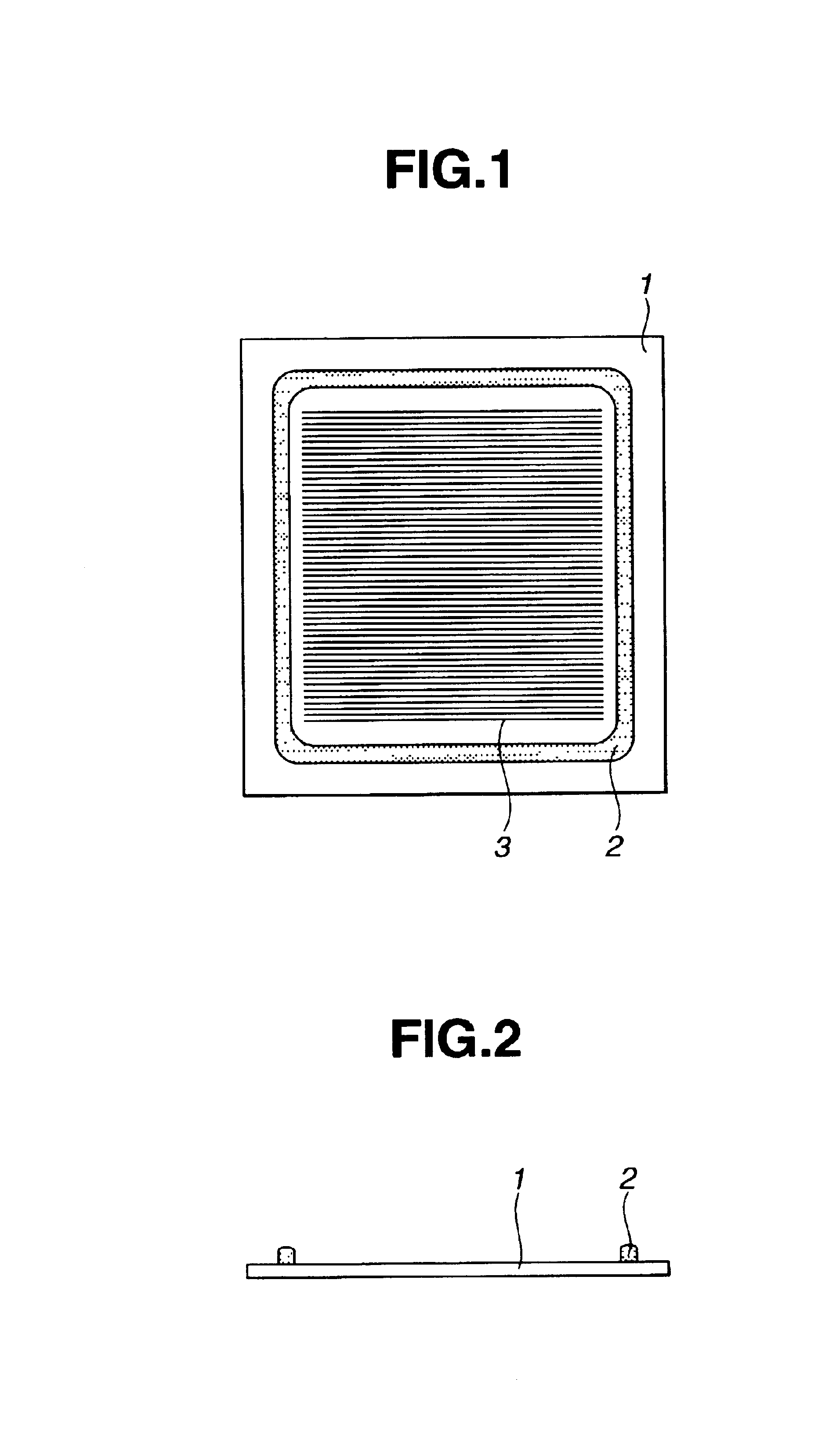Polymer electrolyte fuel-cell separator sealing rubber composition
a technology of polymer electrolyte and fuel cell separator, which is applied in the direction of fuel cell details, tyre parts, vehicle components, etc., can solve the problems of loss of reliability and silicon sealing materials, and achieve the effect of improving acid resistance and long-term servi
- Summary
- Abstract
- Description
- Claims
- Application Information
AI Technical Summary
Benefits of technology
Problems solved by technology
Method used
Image
Examples
example 1
A rubber compound was prepared by mixing 100 parts of polyisobutylene having an allyl radical introduced at either end of the molecular chain (Mn 5,000, viscosity 60 Pa·S) and 20 parts of silica having a specific surface area of 200 m2 / g (Aerosil 200 by Nippon Aerosil Co., Ltd.) in a kneader at 100° C. for 3 hours.
Using a twin-roll mill, 1.5 parts of an organohydrogenpolysiloxane of the formula (i):
C6H5Si—(OSiMe2H)3 (i)
wherein Me is methyl, 0.06 part of ethynylcyclohexanol as an addition crosslinking regulator, and 0.05 part of a 5% isopropyl alcohol solution of chloroplatinic acid were added to the rubber compound. The composition was press cured at 150° C. for 10 minutes to form a sheet of 1 mm thick. A specimen of 30 mm×30 mm cut out of the sheet was examined for acid resistance by immersing it in a 10% aqueous sulfuric acid solution at 100° C. for 500 hours and calculating a weight change. The result is shown in Table 1.
example 2
A rubber compound was prepared by mixing 100 parts of polyisobutylene having an allyl radical introduced at either end of the molecular chain (Mn 5,000, viscosity 60 Pa·S), 10 parts of an organopolysiloxane consisting of 99.85 mol % dimethylsiloxane units, 0.125 mol % methylvinylsiloxane units and 0.025 mol % dimethylvinylsiloxane units and having an average degree of polymerization of about 8,000, and 20 parts of silica having a specific surface area of 200 m2 / g (Aerosil 200 by Nippon Aerosil Co., Ltd.) in a kneader at 100° C. for 3 hours. Using a twin-roll mill, 1.5 parts of an organohydrogenpolysiloxane of the formula (ii):
0.06 part of ethynylcyclohexanol as an addition crosslinking regulator, and 0.05 part of a 5% isopropyl alcohol solution of chloroplatinic acid were added to the rubber compound. The composition was press cured at 150° C. for 10 minutes to form a sheet of 1 mm thick. Acid resistance was tested as in Example 1, with the result shown in Table 1.
example 3
A rubber compound was prepared by mixing 100 parts of polyisobutylene having an allyl radical introduced at either end of the molecular chain (Mn 5,000, viscosity 60 Pa·S), 30 parts of an organopolysiloxane consisting of 99.85 mol % dimethylsiloxane units, 0.125 mol % methylvinylsiloxane units and 0.025 mol % dimethylvinylsiloxane units and having an average degree of polymerization of about 8,000, 20 parts of silica having a specific surface area of 200 m2 / g (Aerosil 200 by Nippon Aerosil Co., Ltd.), and 5 parts of dimethylpolysiloxane blocked with a hydroxydimethylsiloxy radical at either end and having an average degree of polymerization of 5 in a kneader at 100° C. for 3 hours. Using a twin-roll mill, 2.0 parts of an organohydrogenpolysiloxane of the formula (iii):
0.06 part of ethynylcyclohexanol as an addition crosslinking regulator, and 0.05 part of a 5% isopropyl alcohol solution of chloroplatinic acid were added to the rubber compound. The composition was press cured at 150...
PUM
| Property | Measurement | Unit |
|---|---|---|
| Temperature | aaaaa | aaaaa |
| Fraction | aaaaa | aaaaa |
| Fraction | aaaaa | aaaaa |
Abstract
Description
Claims
Application Information
 Login to View More
Login to View More - R&D
- Intellectual Property
- Life Sciences
- Materials
- Tech Scout
- Unparalleled Data Quality
- Higher Quality Content
- 60% Fewer Hallucinations
Browse by: Latest US Patents, China's latest patents, Technical Efficacy Thesaurus, Application Domain, Technology Topic, Popular Technical Reports.
© 2025 PatSnap. All rights reserved.Legal|Privacy policy|Modern Slavery Act Transparency Statement|Sitemap|About US| Contact US: help@patsnap.com



